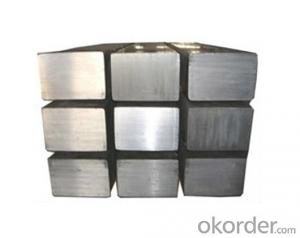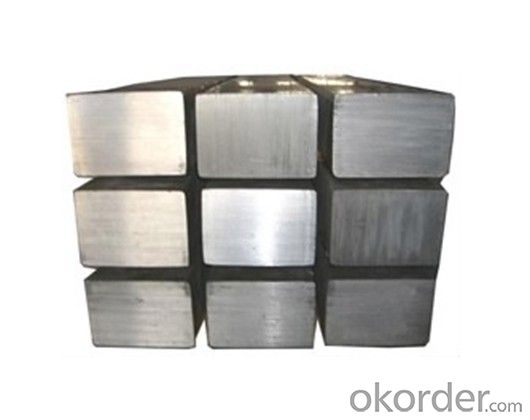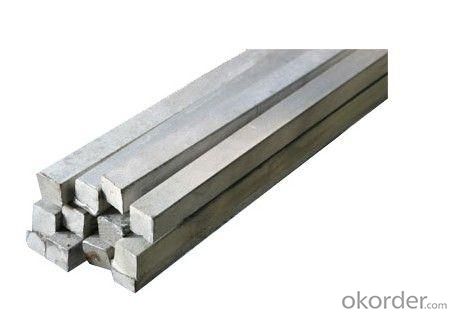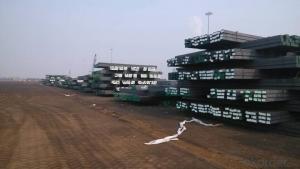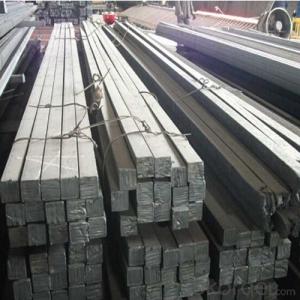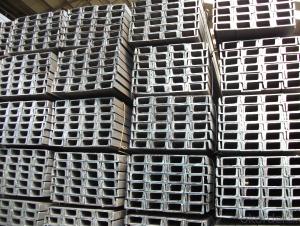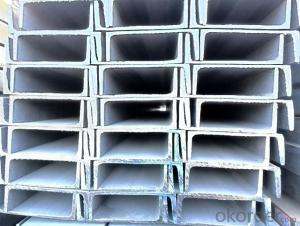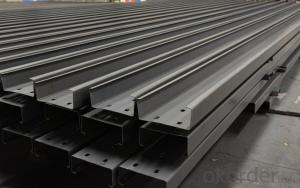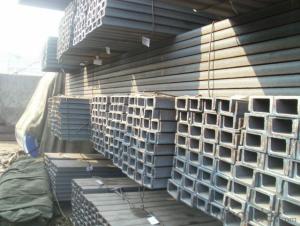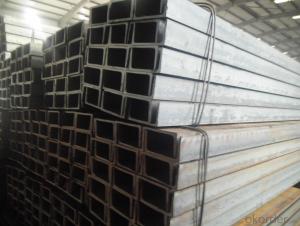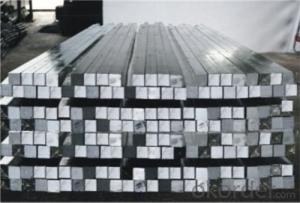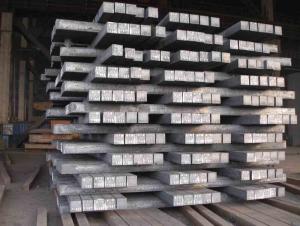JIS U Channel for construction made in China
- Loading Port:
- Tianjin
- Payment Terms:
- TT or LC
- Min Order Qty:
- 10000 m.t.
- Supply Capability:
- 10000 m.t./month
OKorder Service Pledge
OKorder Financial Service
You Might Also Like
Product Description:
OKorder is offering JIS U Channel for construction made in China at great prices with worldwide shipping. Our supplier is a world-class manufacturer of steel, with our products utilized the world over. OKorder annually supplies products to European, North American and Asian markets. We provide quotations within 24 hours of receiving an inquiry and guarantee competitive prices.
Product Applications:
JIS U Channel for construction made in China are ideal for structural applications and are widely used in the construction of buildings and bridges, and the manufacturing, petrochemical, and transportation industries.
Product Advantages:
OKorder's JIS U Channel for construction made in China are durable, strong, and resist corrosion.
Main Product Features:
· Premium quality
· Prompt delivery & seaworthy packing (30 days after receiving deposit)
· Corrosion resistance
· Can be recycled and reused
· Mill test certification
· Professional Service
· Competitive pricing
Product Specifications:
-Standard: GB,
-Grade: Q195 or equivalent.
-Chemical Composition:
Standard | Grade | Element (%) | ||||
GB | Q195 | C | Mn | S | P | Si |
0.06~0.12 | 0.25~0.50 | ≤0.050 | ≤0.045 | ≤0.30 | ||
Measures of HR Square Bar (small measures):
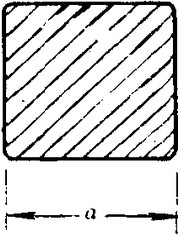
(Section of HR Square Bar)
-Length of a side and Theoretical weight of Square Bar.
Length of a side(mm) | Theoretical weight(kg/m) | Length of a side(mm) | Theoretical weight(kg/m) |
7 | 0.385 | 22 | 3.80 |
8 | 0.502 | 24 | 4.52 |
9 | 0.636 | 25 | 4.91 |
10 | 0.785 | 26 | 5.30 |
11 | 0.950 | 28 | 6.15 |
12 | 1.13 | 30 | 7.06 |
13 | 1.33 | 32 | 8.04 |
14 | 1.54 | 34 | 9.07 |
15 | 1.77 | 36 | 10.17 |
16 | 2.01 | 38 | 11.24 |
17 | 2.27 | 40 | 12.56 |
18 | 2.54 | 42 | 13.85 |
19 | 2.82 | 45 | 15.90 |
20 | 3.14 | 48 | 18.09 |
21 | 3.46 | 50 | 19.63 |
Notes:
1, The theoretical weights in the list, base on the density of 7.85 g/cm3.
2, Formula for theoretical weight of Square bar: (length of a side)2 * 0.00785
3, The numbers with *mean that they are not regular or we don’t offer them.
-Regular length of Square Bar:
Steel | Length of a side (mm) | Length of steel (m) |
Normal steel | < 25 | 4~10 |
> 25 | 3~9 | |
Steel of high quality | All measure | 2~6 |
Tool steel >75 | 1~6 |
Usage/Applications of HR Square Bar:
-The Square Bar is normally used as structure steel.
-Row material for other structure steel like steel angles, channels, I-beams, H-beams, etc…
Packaging & Delivery of HR Square Bar:
-Packing Detail: The products can be packed in bundles by steel wires.
-Marks: We make tag marks and color marks. The tag marks with white background and red company logo will be tied up to each bundle of the products. The information is usually including basic information of products and company and other information requested by customers. As for color marks, we will paint both ends of bundles to make sure that it will be more convenient for customers to distinguish them from other products.
-Delivery Detail: 30~45 working days after receive buyer’s T.T. or L/C.
Transportation:
-The products can be delivered by bulk vessel or by container. As for container, products with the length of 6m will be loaded in 20’ container, with 9m or 12m, in 40’ container.
-The maximum quantity of loading of container is 25 tons.
-The products are usually transported to the nearest port from the production place.
FAQ:
Q1: Why buy Materials & Equipment from OKorder.com?
A1: All products offered byOKorder.com are carefully selected from China's most reliable manufacturing enterprises. Through its ISO certifications, OKorder.com adheres to the highest standards and a commitment to supply chain safety and customer satisfaction.
Q2: How do we guarantee the quality of our products?
A2: We have established an advanced quality management system which conducts strict quality tests at every step, from raw materials to the final product. At the same time, we provide extensive follow-up service assurances as required.

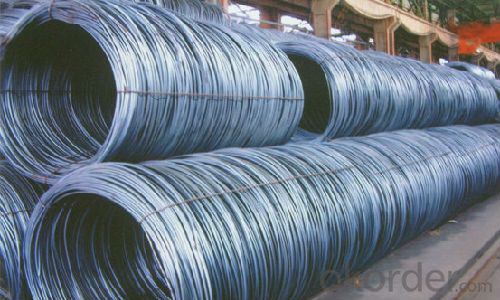
- Q: How does a steel square assist in laying out stairs?
- When it comes to laying out stairs, carpenters and builders rely heavily on the versatility of a steel square. This essential tool is specifically designed to provide accurate measurements and angles, making it invaluable in the construction process. Here are a few ways in which a steel square can assist in laying out stairs: 1. Rise and run determination: By utilizing the tongue and body of the steel square, builders can easily establish the rise and run of each step. Aligning the square with the stringer, the inclined board that supports the steps, allows for precise marking of the height (rise) and depth (run) of each step. 2. Angle setting: Safety and comfort are paramount when constructing stairs, and the steel square's adjustable angle feature proves invaluable in achieving the desired slope. By adjusting the square to the required angle, builders can effortlessly mark and cut the stringers accordingly. 3. Squareness checking: Ensuring that the corners and angles of the stairs are precisely 90 degrees, or square, is crucial for stability and safety. The steel square can be utilized to check the squareness of the stringers and verify proper alignment. This step is essential in avoiding any potential issues with the staircase's stability and safety. 4. Measurement transferring: Another beneficial function of the steel square is its ability to transfer measurements accurately. For instance, when determining the width of the stairs, the square can be used to mark the measurement from the stringer onto the tread, the horizontal part of the step. This ensures consistency and accuracy throughout the layout process. In summary, a steel square is an indispensable tool for laying out stairs. Its ability to measure, mark angles, check squareness, and transfer measurements accurately is highly beneficial for carpenters and builders. By utilizing a steel square, professionals can construct stairs with precision and in compliance with safety standards.
- Q: Can a steel square be used for checking the squareness of a wall frame?
- Yes, a steel square can be used for checking the squareness of a wall frame.
- Q: Can a steel square be used for checking the squareness of a miter saw fence?
- Yes, a steel square can be used for checking the squareness of a miter saw fence. A steel square is a versatile tool that can be used to ensure accurate and precise angles in various woodworking applications, including checking the squareness of a miter saw fence. By placing the steel square against the saw fence and aligning it with the blade, you can determine if the fence is perfectly perpendicular to the blade or if any adjustments are needed. The straight edges of the steel square provide a reliable reference for checking the squareness of the miter saw fence, ensuring that your cuts will be precise and accurate.
- Q: Can a steel square be used for checking the squareness of a countertop?
- Yes, a steel square can be used for checking the squareness of a countertop.
- Q: How do you use a steel square to mark out 30-degree angles?
- Achieving 30-degree angles using a steel square can be done by following these steps: 1. Begin by placing the steel square on the surface or material that requires marking. Make sure that one of the square's legs aligns with a straight edge of the material. 2. Locate the 45-degree angle on the steel square, usually indicated by a mark or notch on the inside corner. 3. After identifying the 45-degree angle, align one leg of the square with the straight edge and position the other leg in the desired direction for creating a 30-degree angle. 4. With the 45-degree mark fixed on the edge, carefully pivot the square along the straight edge. As you pivot, the other leg of the square will rotate, allowing you to mark the 30-degree angle on the material. 5. Once you have achieved the desired angle, use a pencil or marking tool to trace along the square's edge or utilize the square as a guide for drawing a line. Always ensure that your measurements are accurate and double-check that the square is securely positioned on the material to achieve precise markings.
- Q: How do you use a steel square to determine the angle of a roundover cut?
- To determine the angle of a roundover cut using a steel square, the following steps can be followed: 1. Begin by positioning the steel square against the desired edge of the workpiece where the roundover cut will be made. Make sure that the square is perpendicular to the edge. 2. Identify the corner of the square that aligns with the edge of the workpiece. This corner will serve as the reference point for measuring the angle. 3. Place a protractor on top of the steel square, making sure that the center of the protractor aligns with the reference corner. 4. Observe the angle measurement on the protractor where the edge of the workpiece intersects it. This measurement will provide the angle of the roundover cut. 5. Once the angle has been determined, it can be transferred to the woodworking tool you are using, such as a router or table saw, in order to set the appropriate cutting angle. Remember to thoroughly check your measurements and alignment before making any cuts to ensure accuracy. Additionally, exercise caution and adhere to proper safety protocols when working with power tools.
- Q: How to ensure the steel paint off paint
- Authentic traditional painting techniques include the following three steps:The 1. is to use a paintbrush dipped in paint: paint bucket, spread on the coated surface.2., open oil: that is, the shop on the surface of the paint immediately pull open, to promote the film extended evenly.3. paint: paint brushes gently spread evenly with solid particles and straighten out the paint, the paint off and excess paint.You paint square, from top to bottom, by plane, according to my above paint method can ensure the uniform film.In addition, you must use special metal paint finishing of polyester type steel, to ensure no paint brush.
- Q: Can a steel square be used for measuring angles in metal fabrication?
- Indeed, angles in metal fabrication can be measured using a steel square. In metal fabrication, steel squares are widely employed for layout and measurement tasks. Possessing a 90-degree angle and multiple markings along the edges, they facilitate precise measurements and angle determination. Although there are more specialized tools like protractors or digital angle finders available for angle measurement, a steel square suffices for most metal fabrication applications, providing reasonably accurate outcomes. To guarantee accurate angle measurements, it is crucial to calibrate the square correctly and employ it accurately.
- Q: How do you use a steel square to lay out a jack rafter with unequal pitch?
- To use a steel square to lay out a jack rafter with unequal pitch, follow these steps: 1. Determine the pitch: Start by determining the pitch of the common rafter. The pitch is the ratio of the rise to the run, usually expressed as a fraction, such as 4/12 or 6/12. 2. Calculate the pitch of the jack rafter: To determine the pitch of the jack rafter, multiply the pitch of the common rafter by the run of the jack rafter. 3. Set the steel square: Place the steel square on the edge of a board, with the tongue (shorter side) facing up and the body (longer side) resting against the side of the board. 4. Align the square: Slide the square along the board until the edge of the tongue aligns with the run measurement of the jack rafter pitch calculated in step 2. 5. Mark the cut: Hold the square firmly against the board and use a pencil to mark the edge of the board along the body of the square. 6. Repeat the process: Repeat steps 3 to 5 for the other side of the jack rafter, using the same pitch measurement. 7. Connect the marks: Use a straightedge or a chalk line to connect the marks made in step 6. This line represents the plumb cut of the jack rafter. 8. Cut the rafter: Use a saw to cut along the line, following the angle determined by the steel square. By using a steel square and following these steps, you can accurately lay out a jack rafter with an unequal pitch. It is important to measure and mark carefully to ensure a precise cut, as any inaccuracies can affect the overall structure and stability of the roof.
- Q: How do you measure angles with a steel square?
- To measure angles with a steel square, you can align one edge of the square with the reference line and then read the angle measurement directly from the scale provided on the square.
Send your message to us
JIS U Channel for construction made in China
- Loading Port:
- Tianjin
- Payment Terms:
- TT or LC
- Min Order Qty:
- 10000 m.t.
- Supply Capability:
- 10000 m.t./month
OKorder Service Pledge
OKorder Financial Service
Similar products
Hot products
Hot Searches
Related keywords
